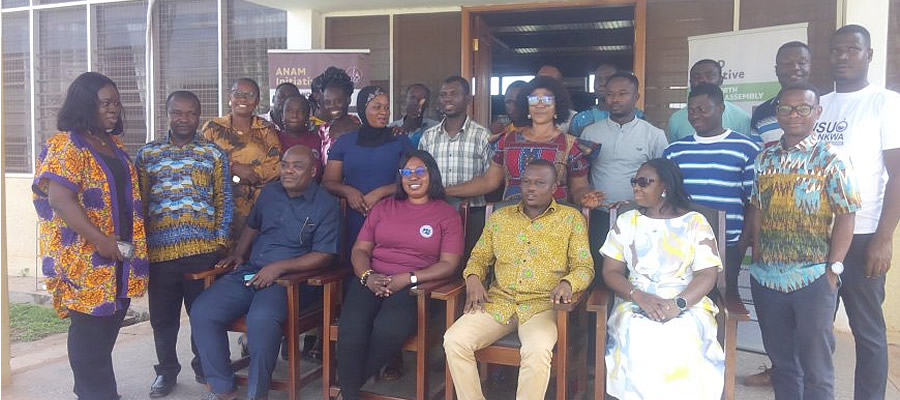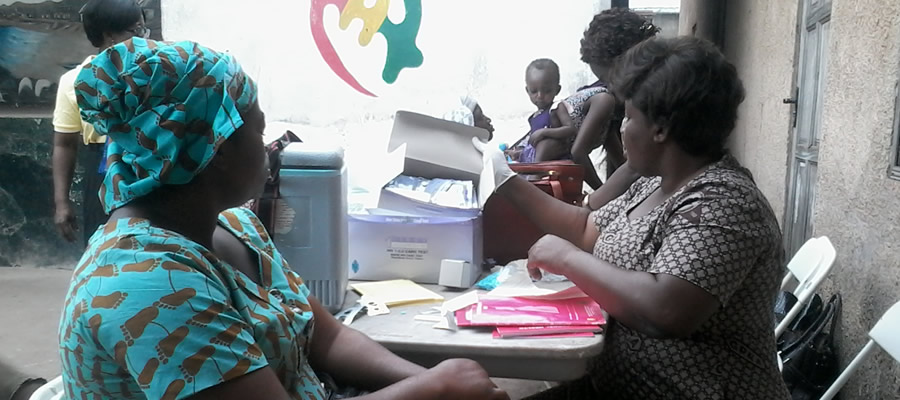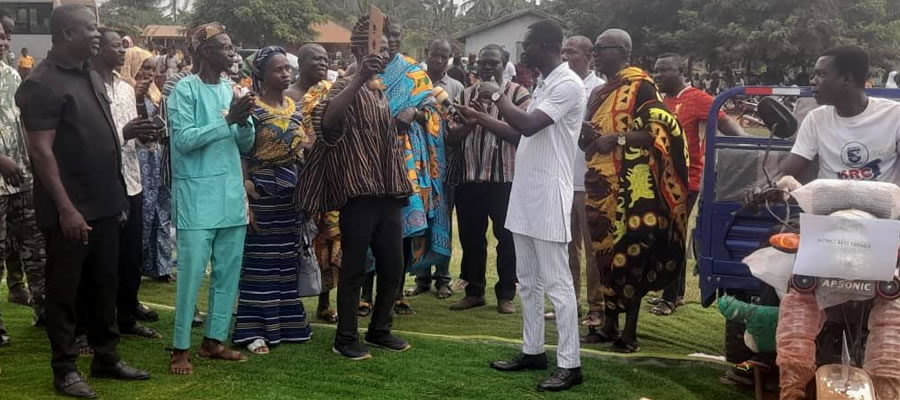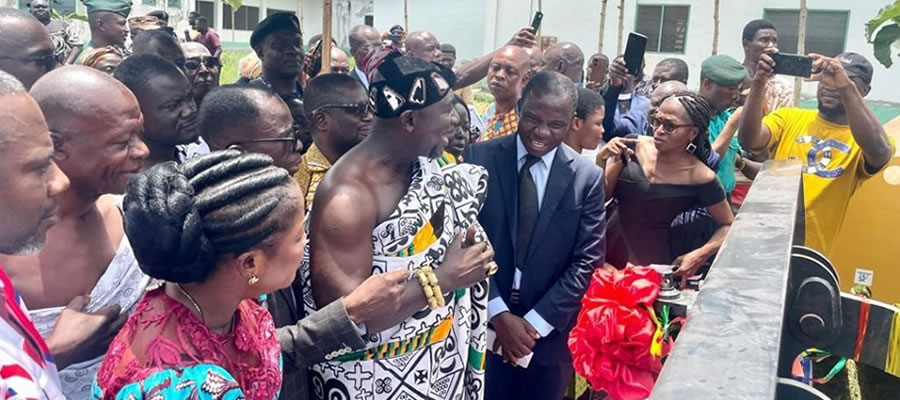

Physical and Natural Environment
The physical and natural environment give a cross point or an interface between human and physical milieu in relation to location and size, climate and vegetation, culture, settlements and population patterns.
Location and Size
The Asutifi North District used to be part of old Asutifi District under LI 1485 of the erstwhile Provisional National Defence Council (PNDC) quest to deepen the decentralisation process in 1988. In June 2012, the Asutifi South District was created leaving the mother District to stand separately as Asutifi North District under LI 2093 with Kenyasi still the District capital. The District is one of the six (6) Districts in Ahafo Region and Two Hundred and Sixty one (261) in Ghana respectively.
The Asutifi North District is located between latitudes 6°40’ and 7°15’ North and Longitudes 2°15’ and 2°45’ West. It shares boundaries with Sunyani Municipal on the north, Tano North and South Municipalities on the north-east, Dormaa East District to north-west, Asutifi South District in the west, Asunafo North Municipal in the south-west and Ahafo Ano North Municipal (Ashanti Region) in the south- east. With a total land surface area of 936 sq.km, the District is one of the smallest in the Ahafo Region. There are a total of over 139 settlements in the District with major towns as Kenyasi I,Kenyasi II, Ntotroso, Wamahinso, Gyedu and Gamabia II. The District capital Kenyasi, is about 50km from Sunyani, the Regional capital of Bono,
Implications of Location of the District for Development
The location of the District in Ahafo Region offers it the opportunity to interact or co-operate with the five Regions of Ghana namely Ashanti, Western and Northern, Upper West and Volta Regions of the country. The western frontier of the Region also makes it imperative for the people to co-operate and exchange goods and services with the neighbouring Ivory Coast. The proximity of the District to Sunyani, the Regional capital has both advantages and disadvantages.
In the case of the latter, the youth turn to drift to Sunyani in search of jobs giving marked deficit of males in the age classes of 20 to 35 years of the District population pyramid even though males outnumber females in the District.
Also, the proximity of the District to Kumasi and Sunyani has made some communities enjoy basic amenities and facilities from both Kumasi and Sunyani which the District lacks. This has improved upon the living conditions of the people in the District.
In a similar vein, the location of the District and its nearness to communities like Hwidiem, Goaso, Tepa in Ashanti Region has also provided opportunity for farmers to market their produce in these towns where there is always ready market.
The upsurge of mineral exploration in Kenyasi and its environs by Newmont Ghana Gold, Ahafo Mine, coupled with the activities of small scale mine has brought the influx of many people far and near to the District. This has increased and boosted the economic activities of the people. The drawback of this is its high cost of living in the District especially Kenyasi.
Climate
The District lies within the wet semi-equatorial zone marked by double rainfall maxima; June and October with a mean annual rainfall between 125cm and 200cm.
The first rainy season is from April to July (maximum) and the second rainy season is from September to October (minimum) when the District comes under the influence of the wet maritime air mass. The beginning of the rainy season is marked by heavy thunderstorms which sometimes cause the ripping off of building roofs. There is a sharp dry season between the two rainy seasons, the main one coming between November and March when the tropical continental airmass in the country sweeps over the area. Relative humidity is generally high ranging between 75% to 80% during the two rainy seasons and 70% to 80% during the rest of the year.
The highest point of the physiographic of the District is about 700 feet above sea level. The lowest part is about 650 feet above sea level found along the river basins whilst the highest point is found within a chain of mountains in the north east reaching a height of 1400 feet above sea level. These mountains form water shed for the many tributaries of Tano River and other streams. There are out crops of gigantic rocks found over Birimian rocks basement standing about 750-900 feet above the broad surface.
Vegetation and Forest Resources
The District lies within the green belt. The over-bearing vegetation is moisture laden semi-deciduous. The typical vegetation is basically determined by rainfall and ground water supplies. The forest is rich in tropical hardwoods like Wawa, Esa, Kyenkyen, Odum, Ofram and Fununtum. In recent times these natural vegetation cover is fast depleting into secondary forest. This is due to excessive and indiscriminate felling of trees especially by illegal chain-saw operators and mining activities. Improper farming practices such as shifting cultivation, uncontrolled bush fires and sand winning activities also add impetus to the depletion of the forest.
These developments call for immediate measures to protect this sensitive ecological zone. There are however, large areas of forest reserves. These include the following:
• Biaso Shelter Belt
• Bia Tam Forest Reserve
• Goa Forest Reserve
These forest reserves together cover a total of about 20% of the entire land surface area of the District.
As far as human settlements are concerned, these forest reserves are seen as a big asset for future generation. Nevertheless, bush fires and other illegal human activities are degrading the forests at an alarming proportion.
The forest also provides timber which serves as a source of revenue and foreign exchange to the District on one hand and the Central Government as a whole. It serves as employment to some of the people who engage in logging. It also serve as a source of industrial raw materials to feed the local industries for the people who are engaged in activities such as carving, carpentry, sawmilling and a host of others in and outside the District. Farmers also depend on the forest for farming to produce food for human consumption. The forests in their entirety provide a major source of energy for cooking as the people get firewood and charcoal in the forest. Importantly, shrubs and trees found in the forest serve as medicinal purposes.
Implications of Climate and Vegetation on Development
From the aforementioned analysis, it could be seen that the vegetation and climate have certain implications for planning and development of the District. The double maxima rainfall supports two crop seasons making it continuous food supply throughout the year within and outside the District. Extensive dry seasons also lead to a long period of drought which does not augur well for agriculture. The rainfall pattern and adequate sunshine support the growing of crops like Cocoa, Cassava, Plantain, among others to thrive well.
Relief and Drainage
The District lies within the forest dissected plateau physiographic Region with average height of about 700 feet above sea level. The lowest part is about 650ft above sea level found along the river basins whilst the highest point is found within a chain of mountains in the north east reaching a height of 1400 feet above sea level. These mountains form water-shed for the many tributaries of the Tano River and other streams. There are out-crops of gigantic rocks found over Birimian rocks basement standing about 750 - 900 feet above the broad plateau surface.
The District is drained by Tano River and its many tributaries which include Nsubin, Goa and Ntotro rivers exhibiting a dentric pattern. These youthful fast flowing rivers have cut up the plateau surface giving rise to the dissected nature of the plateau.
The persistent clearing of the catchment areas of these rivers and streams for farming purposes has adversely affected their level of flow or volume. They have virtually become seasonal rivers. During the dry season too, some of the rivers lose the level of flow and streams dry up. Several communities also face acute water shortage, albeit the rivers serve as major sources of domestic water supply.
Rivers and streams take their source from these hilly areas. These rivers and streams ultimately serve as a source of drinking water to the various communities in the District. On the other hand, the relief and drainage influence climatic conditions in terms of rainfall patterns and farming activities.
Implications of Relief and Drainage on Development
The relief and drainage have implications for the development of the District. First, the existence of several streams and rivers in the District enhance irrigation which promote all year round farming activities. In addition, streams and rivers found in the District provide sources of water for domestic use. Furthermore, rocky hills and out-crops serve as employment for the people.
In spite of importance of relief and drainage to the District, there are also associated problems that go with them. Soil erosion is very pronounced in the highlands. As a result, top soils on the highlands are always washed away most especially when it rains making farming difficult. The undulating nature of the land in certain parts of the District makes construction of some projects especially roads in the District very difficult.
Geology and Minerals
Within the Birimain and Dahomeyan formations with natural resources or potentials such as granites, clay, sand, gold, diamond deposits and the like. The Birimian formations are known to be the gold bearing rocks. The Birimian rocks also have a high potential for Manganese and Bauxite. Currently, gold is being mined in area where these rocks are found by Newmont Ghana Gold Limited, one of the biggest mining companies in the world. These areas include Kenyasi No.1&2, Ntotroso, Gyedu-Wamahinso and other smaller communities. However, other exploration activities are on-going in other communities within the District.
Studies have shown that Diamond abounds in large quantities at Wamahinso and exploration is yet to begin. There is also a widespread deposit of sand and clay in the District. The sand and clay deposits can be found at Kenyasi, Gambia No.2 and Gyedu.
There are rounded out-crops of granite found over the Birimian rocks at Kwadwo Addaekrom, Goa Asutifi, and other smaller communities which have high potential of iron and bauxite.
Implications of Geology and Minerals to Development
In the Asutifi North District, geology helps to determine the distribution of minerals as already put forth. The geology, with regard to the District gives an insight into the general nature and pattern of the soil. It has major influence on the drilling of wells and boreholes as compared to other places where drilling becomes difficult because the nature of the land is sandy without rocks.
Date Created : 11/14/2017 4:14:52 AM












 facebook
facebook
 twitter
twitter
 Youtube
Youtube
 +233 593 831 280
+233 593 831 280 0800 430 430
0800 430 430 GPS: GE-231-4383
GPS: GE-231-4383 info@ghanadistricts.com
info@ghanadistricts.com Box GP1044, Accra, Ghana
Box GP1044, Accra, Ghana